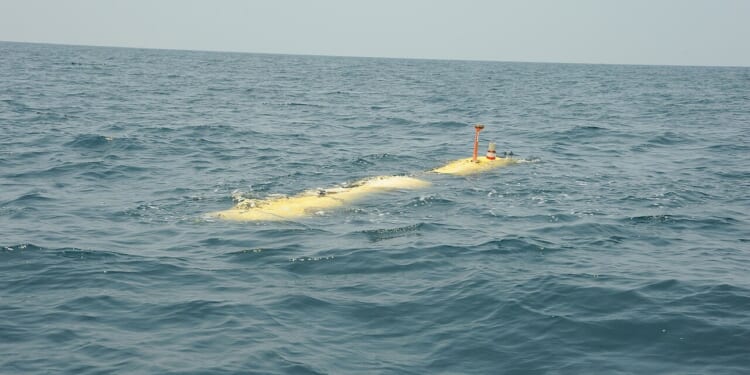The most recently recovered drone is now undergoing “detailed forensic examination to determine its exact origin, operational history, and potential security risks.”
Last week, the Philippine Coast Guard (PCG) shared a photo of a very unique “catch of the day” made by Filipino fishermen. At 12 feet in length, the catch would have already been impressive in any case, but it was made more so because it was not a fish—or other sea creature. Instead, the PCG said that commercial fishermen hauled in a suspected underwater drone in Philippine territorial waters near Sitio Tapic., off the western coast of the archipelago.
The unmanned underwater vehicle (UUV) is just the latest drone to be recovered, believed to be of Chinese origin. Between July 2022 and December 2024, the PCG claimed to have recovered at least five other UUVs, all of which were linked to Beijing. The drones were outfitted with SIM cards and other components made in China, the PCG said in a statement shared on social media.
The UUVs, which have also been described as autonomous underwater vehicles (AUVs) by the PCG, were unarmed but outfitted with tools for “advanced underwater surveillance and seafloor mapping.” The drones are believed to have been deployed to collect data on the depth, salinity, temperature gradients, and other details about the waters of the South China Sea, including those within the Philippines’ exclusive economic zone (EEZ).
The PCG has further said that the recovery of this latest drone serves to highlight illegal scientific research undertaken by China in Philippine waters.
“We commend the quick action of the local fishermen for reporting this find. This incident highlights the need for continued community awareness and a whole-of-nation approach to deter unauthorized activities in our waters,” said PCG Commandant, Admiral Ronnie Gil Gavan.
The most recently recovered drone is now undergoing “detailed forensic examination to determine its exact origin, operational history, and potential security risks.” The PCG has called up Filipino citizens to report any suspicious maritime objects to officials.
Why Would China Deploy Its Drones Around the Philippines?
Beijing maintains ownership of the near entirety of the South China Sea, which overlaps with claims of Malaysia, Taiwan, Vietnam, Brunei, and the Philippines. In 2016, an arbitral tribunal in The Hague dismissed China’s claims, but Beijing has largely ignored the ruling.
Manila also disputes the territorial claims where the drones have been discovered. Yet, that hasn’t stopped Chinese vessels from carrying out research operations within the Philippines’ EEZ. In September, a suspected “drone mothership” was operating near the Scarborough Shoal, while other research vessels have been spotted within the EEZ.
Territorial disputes in the South China Sea aren’t new; tensions first flared over the waters in the late 18th century. In the years leading up to the Second World War, competing claims to the Paracel and Spratly Islands emerged, which were subsequently occupied by the Japanese during the conflict.
The disputes go far beyond the small patches of land. Fundamentally, they are about control of the South China Sea, which is believed to be rich in oil and natural gas deposits. The waters are also home to fishing grounds that provide the livelihoods of millions of people throughout the region, with more than half of the world’s fishing vessels operating in the area.
The waters continue to be a major shipping route, and in 2016, more than 40 percent of Beijing’s total trade transited the South China Sea. The United Nations Conference on Trade and Development estimated that over 21 percent of global trade, amounting to $3.37 trillion, also traveled through the waters.
Beyond research drones, China has been developing extra-large uncrewed underwater vehicles (XLUUVs), which could play a crucial role in controlling the South China Sea and beyond.
About the Author: Peter Suciu
Peter Suciu has contributed over 3,200 published pieces to more than four dozen magazines and websites over a 30-year career in journalism. He regularly writes about military hardware, firearms history, cybersecurity, politics, and international affairs. Peter is also a contributing writer for Forbes and Clearance Jobs. He is based in Michigan. You can follow him on Twitter: @PeterSuciu. You can email the author: [email protected].


















